To vibrate or not to
vibrate, that is the question:
The evidence of early orchestral performances on film
by Tomoyuki Sawado (Sonetto Classics)
In 2010, the British conductor Roger Norrington released a
controversial recording of Mahler's Ninth Symphony on the Hänssler
Classic label. In that performance, he stipulated that the players of
the Radio-Sinfonieorchester Stuttgart des SWR perform without
continuous vibrato -a decision based on a provocative theory he had set
out earlier in articles in The New
York Times (1) and The
Guardian
(2). Norrington insisted that when great composers like Brahms and Berg
created their works "there was only one orchestral sound: a warm,
expressive, pure tone, without the glamorized vibrato we are so used
to." In the Times, he
summarized his findings thus:
"In the early 20's the more sensuous and entertainment-minded French
players began to experiment with continuous vibrato, and the British
followed suit in the late 20's. But the high-minded Germans and most of
the big American institutions held out until the 30's. The Berlin
Philharmonic does not appear on disc with serious vibrato until 1935
and the Vienna Philharmonic not until 1940."
This theory provoked considerable debate, and was criticized by many
scholars and critics. The American critic David Hurwitz, for instance,
dismissed the recording as "ridiculous" and "stupid" (3), and
challenged Norrington's theory by presenting numerous examples of
written documents supporting the idea that vibrato was commonplace in
orchestral performances even in the nineteenth century (4).
Norrington mainly relied upon recordings and probably some written
documents to make his case; Hurwitz, by contrast, examined a vast
number of letters, articles, interviews, and musical scores, though he
did not really consider audio recordings to be reliable sources (4) -a
decision that was probably appropriate given the limitations of
recording technology in the pre-war era. A few early sources, such as Arthur Nikisch's 1913
recording
of Beethoven's Fifth Symphony, with the Berlin Philharmonic, do display
a non-vibrato-like sonority from string players, but in most such cases
it is difficult to determine, from the audio alone, the degree of
vibrato in the original performance.
Compared with audio sources, written documents, including interviews
and
memoirs, provide detailed information without being influenced by
technological limitations; however, they also inevitably involve
hearsay, and are influenced by subjective perceptions. Mahler once
described vibrato (to Natalie Bauer-Lechner) as "a liquefied pulp
without substance or form," and, according to Reinhold Kubik, "favoured
instead a short-range, declamatory style of 'baroque' articulation"
(5). On the other hand, Herbert Borodkin, who played under Mahler in
the New York Philharmonic, remembered that Mahler requested vibrato
more than any conductors living around the 1960s (4). The apparently
contradictory information about Mahler's taste underscores how
difficult it is to identify precisely the style of an early orchestral
performance based on
hearsay evidence.
The focus of this article is not on Mahler but on the use of vibrato in
the early twentieth century, and to this end I have studied film
footage made before 1935, in the belief that visual sources provide the
most direct and reliable way of determining the level of vibrato in an
orchestral performance. Though the quantity of footage from this period
is very limited, the surviving films I have examined indicate that
vibrato was already used in the New York Philharmonic in 1926, in
the Berlin
Philharmonics in 1931, and in the Vienna Philharmonics in 1933, in
contrast
to Norrington's
claims.
Analyses
Charles Barber, the conductor and artistic director of City Opera
Vancouver and the author of Corresponding
with Carlos: A Biography of Carlos Kleiber,
documented the work of more than three hundred conductors in a large
film collection he donated to Stanford University (6). According to
Barber, the first films to document professional conductors were made
in 1913 by Oskar Messter and captured Nikisch, Weingartner, von Schuch,
and Oskar Fried, though only the film of Nikisch, conducting the Berlin
Philharmonic, survives. That silent film shows Nikisch conducting, from
both
front and back, but does not show any orchestra members.
Several sound films of orchestras made between 1926 to 1935 show string
players apparently using a considerable amount of vibrato. For example,
films showing Fritz
Stiedry (conducting the Staatskapelle Berlin, 1930), Fritz Busch (Staatskapelle
Dresden, 1933), Erich
Kleiber (Staatskapelle Berlin, 1932), Max
von Schillings (Staatskapelle Berlin, 1932), Felix Weingartner
(Paris Symphony Orchestra, 1932), Leo Borchard
(Staatskapelle Berlin, 1933), Leo Blech (Staatskapelle Berlin,
1933), and Karl
Elmendorff (Orchester der Bayreuther Festspiele, 1933) are all
consistent with Norrington's claim that continuous
vibrato was already used in German and French orchestras by the 1930s.
Other early films, however, contradict Norrington's views; five
examples
follow.
--Click
images to watch videos--
1) Wagner, Overture to Tannhäuser: Henley Hadley
conducting the New York Philharmonic (1926).
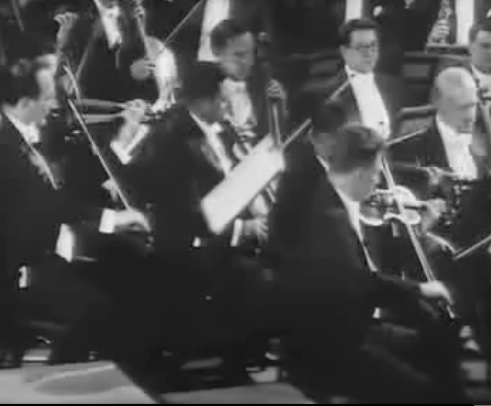
(click to
download)
In this excerpt from the earliest surviving film showing an entire
orchestra in performance one easily observes that the string players'
style is no different from that of a modern orchestra; the use of
continuous vibrato being particularly extensive in the cello section.
This footage, which captured arguably the most famous American
orchestra of the 1920's, is inconsistent with Norrington's remarks that
"most of
the big American institutions held out until the 30's" (1)(2) and
"orchestras didn't generally use vibrato until the 1930s" (7).
2) Carl Maria von Weber, Overture
to Oberon: Bruno Walter
conducting the Berlin Philharmonic (1931).
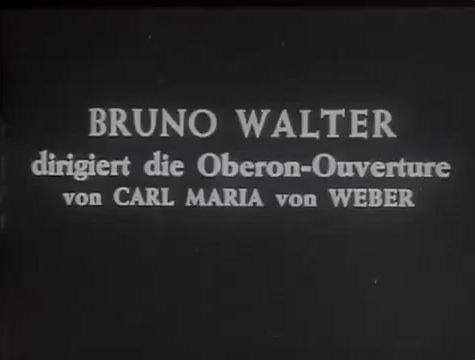
In this performance,
conducted by Bruno Walter, vibrato is extensively used throughout in
the cello (e.g. 1:43-2:22, and 5:27-5:35) and violin
sections (e.g. 4:04-5:00, and 7:23-7:27). Similar degrees of continuous
vibrato are used in footage of the same work performed by the same
orchestra under Mariss
Jansons (8). This suggests that the Berlin Philharmonic's current
performance style, with
continuous vibrato, was already established
in 1931.
3) Christoph Willibald Gluck, Orfeo ed Euridice. Bruno Walter conducting the Vienna
Philharmonic (1933).
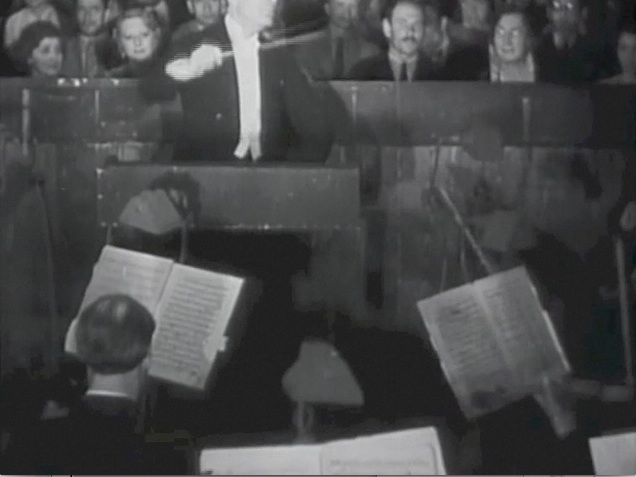
A
few opera scenes were filmed during the Saltzburg festival in 1933 (9),
and
they include probably the earliest footage of the Vienna Philharmonic.
In the scene where Rossete Anday sings
Che farò senza Euridice
under Bruno Walter, a camera captures players' left hands playing
vibrato.
4) Excerpt from Maskerade: Vienna Philharmonic
(1934).
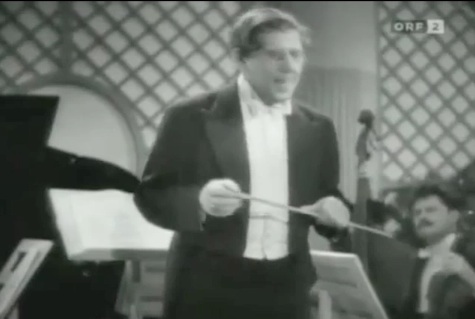
In 1934, the Vienna Philharmonic appeared in Maskerade
(also known as Masquerade in Vienna),
an Austrian film directed by Willi Forst. Philharmonic members
appear in a ballroom to perform a work "by Johann Sebastian Bach". When
they play in unison, the violin player does not use vibrato, but one
can briefly see a cellist's left hand creating vibrato (below the
conductor's right hand); however, it is difficult to definitively
evaluate the overall degree of vibrato from such a short sequence.
Maskerade
also contains an extended but frequently interrupted sequence of the
orchestral performance near the end. The Vienna
Philharmonic performs Verdi's "Rigoletto"
in an orchestra pit, and the cameras capture a few players in the
cello section
routinely using considerable degrees of vibrato (1:27:30,
1:29:49-1:30:03, 1:31:13, and 1:31:27-1:31:40 of (10)).
5) Excerpt from Letzte Liebe:
Vienna Philharmonic (1935).
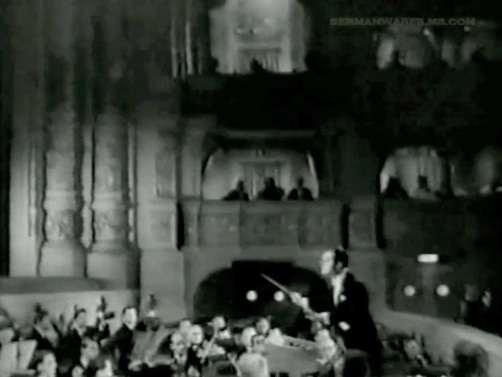
The other early footage of the Vienna Philharmonic appears in
the 1935
Austrian film Letzte Liebe,
directed by Fritz Schulz. The orchestra plays the overture to Don Giovanni
in an opera house. A cellist uses vibrato in the opening bars, and one
passage shows three out of five violinists using vibrato (0:55 to
1:05); significantly, one of the violinists who does not use
considerable vibrato in the latter sequence (or in the opening bars) is
none other than Arnold Rosé.
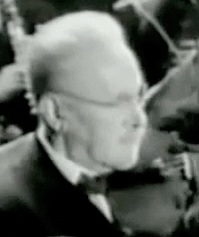
Rosé was the Vienna Philharmonic's concertmaster from 1881 to 1938, and
it was his non-vibrato style, in a 1928 recording with his quartet,
that formed the basis for Norrington's non-vibrato interpretation of
Mahler's Ninth Symphony: "He led the orchestra all the time Mahler, his
brother-in-law, directed the opera. We can hear Rosé on records with
his string quartet as late as 1928, playing with exemplary clarity and
naturalness and without anything resembling modern vibrato" (1).
Rosé's dislike of vibrato was well documented. When the violinist Otto
Strasser auditioned for the Vienna Philharmonic, Rosé and Frantz Schalk
were on the panel. According to Strasser, Rosé "was not keen at all on
vibrato which had long ago become common practice," and employed it
"only sparingly." When Strasser was asked to
play a phrase from Lohengrin,
Schalk, who shared Rosé's views, stopped Strasser and said, "Stop
bleating like that" (11).
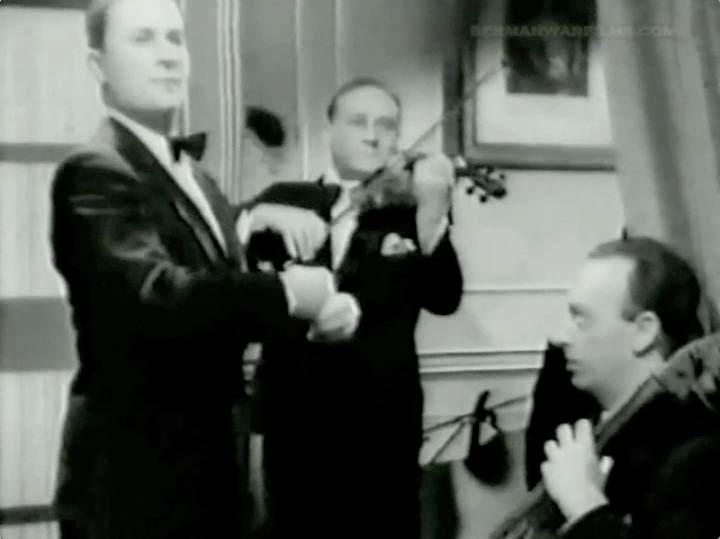 This
particular film raises two important points. First, as we might have
predicted from his recordings and the documentary record, Rosé indeed
does not use vibrato extensively though it should be noted, however,
that he does not entirely avoid it (see 0:55 to 0:58 and 1:05 to 1:06).
This
suggests that his playing style essentially differs from the
non-vibrato style we observe today in period-instrument performances.
Second, Rosé's influence over Vienna Philharmonic members was
apparently not decisive in 1935, since three out of five violinists,
and a cellist, can clearly be seen using vibrato in the film. This
conclusion is supported by another example from Letzte Liebe, in which musicians
(presumably also Philharmonic members) play the minuet from Don Giovanni
in a restaurant right after the opera; here both the violinist and the
cellist use a considerable amount of vibrato. Therefore, despite
Norringron's claim that there is "no vibrato" in audio sources recorded
by the Vienna Philharmonic before 1940's (1)(2)(12), there were
evidently two types of players in the orchestra
in 1935: those who preferred vibrato and those who did not. Rosé
himself disliked it, but clearly did not have or use the authority to
impose his taste on the whole orchestra.
This
particular film raises two important points. First, as we might have
predicted from his recordings and the documentary record, Rosé indeed
does not use vibrato extensively though it should be noted, however,
that he does not entirely avoid it (see 0:55 to 0:58 and 1:05 to 1:06).
This
suggests that his playing style essentially differs from the
non-vibrato style we observe today in period-instrument performances.
Second, Rosé's influence over Vienna Philharmonic members was
apparently not decisive in 1935, since three out of five violinists,
and a cellist, can clearly be seen using vibrato in the film. This
conclusion is supported by another example from Letzte Liebe, in which musicians
(presumably also Philharmonic members) play the minuet from Don Giovanni
in a restaurant right after the opera; here both the violinist and the
cellist use a considerable amount of vibrato. Therefore, despite
Norringron's claim that there is "no vibrato" in audio sources recorded
by the Vienna Philharmonic before 1940's (1)(2)(12), there were
evidently two types of players in the orchestra
in 1935: those who preferred vibrato and those who did not. Rosé
himself disliked it, but clearly did not have or use the authority to
impose his taste on the whole orchestra.
Conclusion
The
analysis of surviving film footage suggests that vibrato was
extensively used in New York Philharmonic in 1926, in the Berlin
Philharmonic in 1931, and in the Vienna Philharmonic in 1933-35, in
contrast to Norrington's claim. In the Vienna Philharmonic, moreover,
some players used vibrato while others did not, and it is not clear
whether the orchestra had been in that state for many years or was in
the middle of a transition from a non-vibrato to a continuous-vibrato
style. Analysis of more early film footage will be required to solve
lingering questions related to the degree of vibrato.
(October 13th, 2013) Copyright (C) 2013 T. Sawado, All Rights Reserved.
Reference
(1) Roger Norrington, "Time to Rid Orchestras of the Shakes," The New
York Times, February 16, 2003.
(2) Roger Norrington, "Bad Vibrations," The Guardian, March 1, 2003
(3) David Hurwitz, "Roger Norrington's Stupid Mahler Ninth,"
ClassicsToday.com, 2010.
(4) David Hurwitz, " 'So klingt Wien': Conductors, Orchestras, and
Vibrato in the Nineteenth and Early Twentieth Centuries,” Music
& Letters, Vol. 93, Issue 1 (February 2012), pp. 29-60.
(5) Reinhold Kubik, "'Progress' and 'Tradition': Mahler's Revisions and
Changing Performance Practice Conventions," in Perspectives on Gustav
Mahler, ed. Jeremy Barham (Aldershot, England, and Burlington,
VT:
Ashgate Publishing Limited, 2005), p. 404.
(6) Conductors on Film Collection (Charles Barber Collection), Archive
of Recorded Sound, Department of Music, Stanford University (Stanford,
CA).
(7) Nicholas Wroe, "Speed it up", The
Guardian, July 27, 2007.
(8) THE BERLINER PHILHARMONIKER IN
TOKYO, Hilary Hahn/Berlin Philharmonic/Mariss Jansons. DVD,
Euroarts, 2000
(9) Great Conductors: The Golden Era
of Germany and Austria. DVD,
Dreamlife, 2008
(10) Maskerade (1935). DVD,
Hoanzl, 2010
(11) Otto Strasser, Und dafür wird
man noch bezahlt: Mein Leben mit den
Wiener Philharmonikern (Vienna and Berlin: Neff), 1974.
(12) Richard Dyer, "Sir
Roger Norrington still conducts challenges to the tradition", The
Boston Globe, August 25th, 2002.
Acknowledgments
I would like to thank Mr. Angelo Villani, Ms. Zerlina Mastin,
and Mr. Kevin Bazzana for commenting on earlier versions of this
article, and Dr. Charles Barber for providing information about the
films cited.
9/14/2014
Melo Classic has recently uploaded a 1933 film,
in which Clemens Krauss conducts the Vienna State Opera Orchestra,
which is the mother organization of the VPO. The
orchestra in the film uses contenious vibrato.






